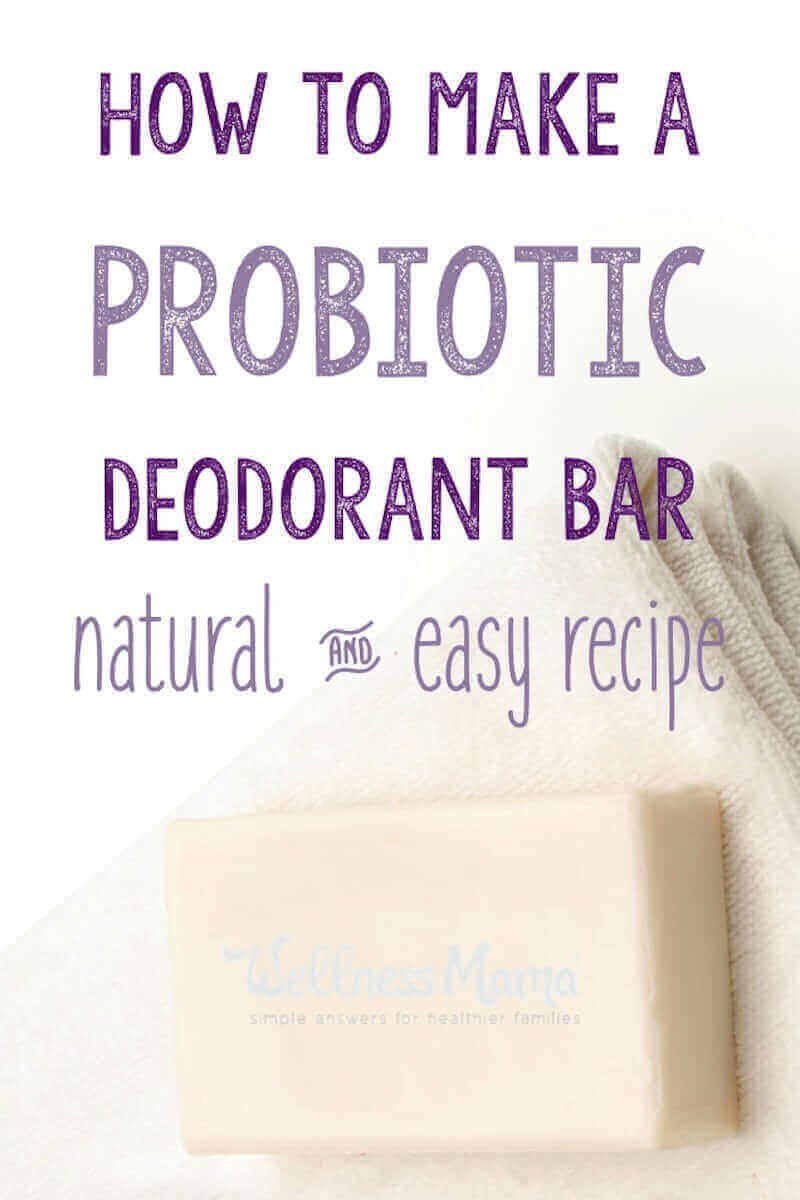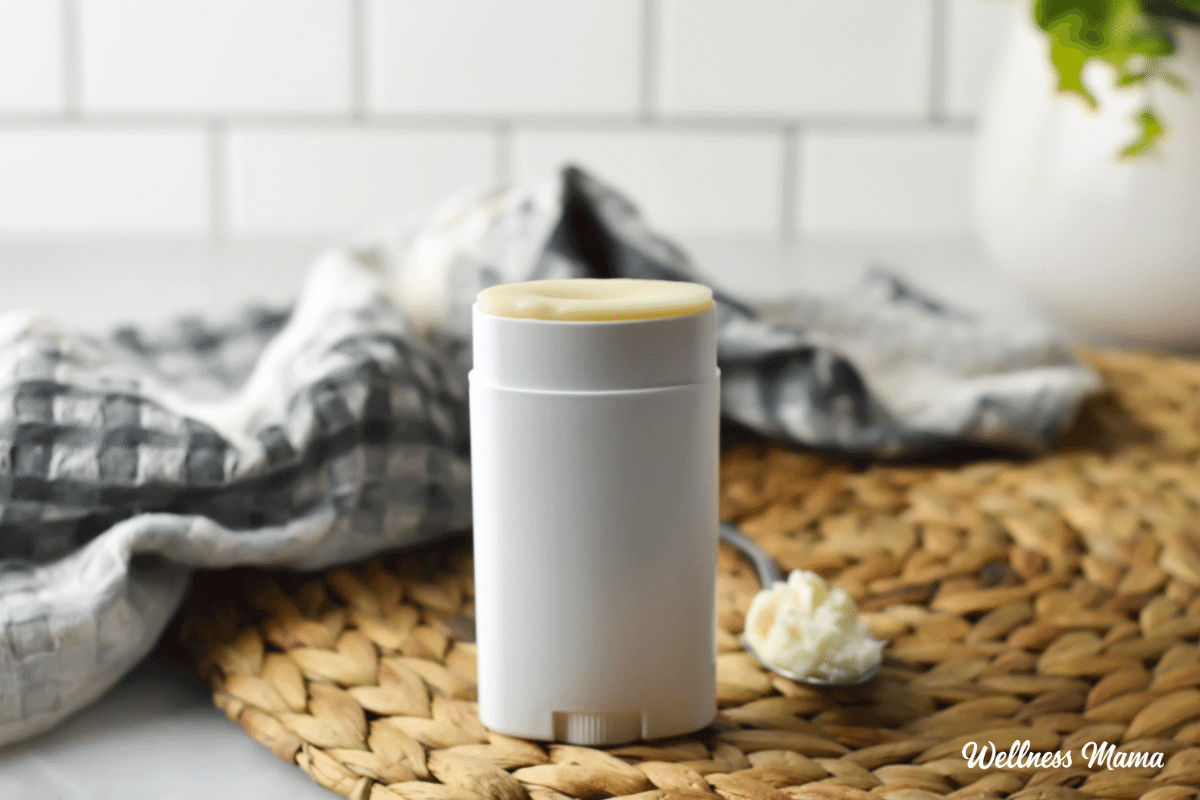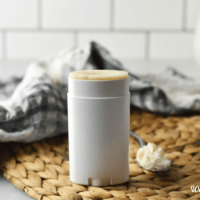Natural deodorant has gotten really popular in recent years, but a lot of people have mixed results. This probiotic deodorant recipe doesn’t just mask the odor, it attacks it at the source!
One of the most asked questions on my popular homemade deodorant post is: “Can I put this in a plastic deodorant container for easy application?”
And the answer is- absolutely yes! But it will work better if you make a couple of tweaks! I’ve played with my original recipes to create several different variations, including this probiotic deodorant.
Why Do Armpits Stink?
Before we go into fixing the problem, it helps to know why it’s there in the first place. Conventional deodorants work by covering up body odor with fragrances. They also clog pores with aluminum to prevent sweating. But why do we get stinky to begin with?
B.O. 101
Like the rest of our skin, underarms have a natural microbiome complete with bacteria. When things are unbalanced and the bad bacteria is in charge it causes stanky pits. This odor-causing bacteria, not sweat itself, is to blame. According to Popular Science:
“Sweat by itself doesn’t actually smell. It contains long chains of molecules that are too heavy to vaporize and reach your nostrils. But the bacteria in your pits break down these big molecules into smaller molecules that fly off, and depending on what kind of bacteria are living on you, those volatiles can smell pretty foul.”
What we eat plays a big role in our underarm bacteria, as do healthy (or unhealthy) lifestyle choices. Genetics can also play a part. Our bodies detox through the sweat in our armpits. If there are more toxins released into our system, then naturally there’s more stinky sweat.
Why Natural Deodorant Doesn’t Work
Many people who make the switch to natural deodorant are disappointed with the results at first. They may notice an increase in underarm wetness or even smell. Then there’s the infamous baking soda rash. But what’s really going on here?
If our skin is used to having blocked pores preventing it from sweating, then there’s a backlog of toxins. That area is also rich in lymphatic tissue which helps us eliminate waste products. Using natural deodorant helps to support these natural processes, but it takes time to balance things out.
Start with a Detox
If you’re new to natural deodorant, I’ve found an armpit detox, done once a week or so, greatly speeds up the adjustment period. It also makes the deodorant more effective more quickly. Here’s how to detox your pits.
Since switching to a natural deodorant I’ve gradually noticed less underarm odor and sweating.
Probiotic Deodorant Bar
That said, how can probiotics help us have healthier (less stinky!) pits? Probiotic deodorant works by adding more of the good bacteria to the skin microbiome. Over time this helps push out more of the bad bacteria strains that cause odor.
Some of the healthy bacterial strains found in armpits include Staphylococcus epidermidis and Propionibacterium acnes. Outside of test tubes meant for a lab, these strains are harder to source. Instead, most probiotic deodorants rely on strains normally found in the human gut, like lactobacillus supplements. While they’re still beneficial for skin, the effects may be more transient.
These nourishing probiotic deodorant bars are slightly thicker than my original homemade deodorant recipe in a jar. It also uses many of the same ingredients as my lotion bars and sunscreen bars. You can order the ingredients in bulk and save a lot of money on your family’s skincare products this way.
If you have sensitive skin or struggle with odor, this can be a great option! I did include some baking soda to help control odor. If you’re very sensitive you can replace it with more arrowroot for a baking soda free version.
Choose Your Scent
Essential oils naturally have antimicrobial properties that make them great for homemade deodorant. My favorite here are lavender, frankincenses and citrus essential oils. Here are a few more skin-safe options. You can also do an unscented version if desired.
- Grapefruit
- Eucalyptus
- Sweet Orange
- Tea Tree
- Cypress (helps minimize sweating)
- Fir needle
Try making your own deodorant if you haven’t already. You’ll not only save money and avoid synthetic chemicals, but I’ve found the homemade versions work better too!
Probiotic Deodorant Recipe
Equipment
- Quart-size mason jar (optional)
Materials
- ¼ cup coconut oil
- ¼ cup shea butter (or cocoa butter or mango butter)
- ¼ cup beeswax pellets
- ½ tsp vitamin E oil (optional)
- 1 TBSP baking soda (replace with arrowroot powder for sensitive skin)
- 6 TBSP arrowroot powder
- 3 capsules probiotics (the kind that aren't refrigerated)
- 35 drops essential oils of choice (optional)
Instructions
- Combine coconut oil, shea (or other) butter, and beeswax in a double boiler, or a glass bowl over a smaller saucepan with 1 inch of water in it. Combine in a quart size glass mason jar with a lid instead and place this in a small saucepan of water until melted. This will save your bowl and you can just designate this jar for these types of projects and not even need to wash it out…
- Turn the burner on and bring the water to a low boil. Stir ingredients occasionally until they're melted and smooth.
- Remove from heat and add the vitamin E oil, baking soda, arrowroot powder, probiotics, and essential oils. Make sure the mixture is not hot to the touch (warm is ok) so that the heat doesn’t kill the probiotics. If you're using the brand I've linked above, they're fine at higher temperatures.
- Gently stir by hand until all ingredients are incorporated.
- Let cool for about 15 minutes, until the mixture is slightly thickened, but still a pourable consistency.
- Pour the deodorant mixture into new or repurposed and cleaned deodorant containers. Let dry overnight to fully harden.
Notes
- This recipe can be adjusted to make any quantity that you’d like by increasing the amount of ingredients used.
- Shea butter yields a softer deodorant consistency, while cocoa butter is much firmer. You can also use a blend of shea butter, mango butter, and/or cocoa butter.
Deodorant FAQs
Why is mine taking so long to harden?
This is common when using the baking soda. Try putting it in the fridge for a few hours to harden. I actually like keeping mine in the fridge all the time and applying it while I’m making breakfast since it keeps it really cool and refreshing.
It seems to be leaving stains on my shirt- what do I do?
This is likely due to the oil residue that’s there for a few minutes right after applying. Try keeping it in the fridge so a smaller amount is transferred to the skin. Or wait about 5 minutes after applying before putting a shirt on.
Help! I have a horrible rash after a few days/weeks/months of using this.
This is common in some skin types and if you’ve used conventional deodorant for a long time. I’ve found that doing an armpit detox once a week makes a huge difference. You can also try omitting the baking soda from the recipe. This resolves the issue for most people.
Is this an antiperspirant?
No. Stopping the body’s ability to sweat is not a natural process. There’s no way I know of to do this naturally. The good news is that you’ll sweat less as your body adjusts to a natural deodorant and it won’t be needed anymore. Again, the armpit detox can help speed that up. I went from using clinical strength deodorant to not needing an antiperspirant at all!
I’m allergic to coconut oil
If you have a coconut allergy then you can use 2 Tablespoons of a liquid oil instead of the 1/4 cup of coconut oil. Olive oil, grapeseed, and sweet almond oil are several different options.
Have you ever made your own deodorant? How did it go? Leave a comment below and let me know!






Leave a Reply